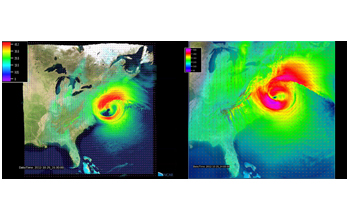Multimedia Gallery
Simulation of Hurricane Sandy showing horizontal wind at 1000 meters
Two frames from a simulation of Hurricane Sandy showing wind at 1000 meters with horizontal wind vectors. Key features include a well-defined wind maximum (> 40 m/s) encircling Sandy's inner core, persistent throughout the simulation, and development of a well-defined outer radius wind maximum concurrent with cold air enrichment. Color indicates wind speed in m/s.
The simulation was created by a team of researchers from the U.S. National Science Foundation-supported National Center for Atmospheric Research and National Center for Supercomputing Applications, and by Cray Inc. Support was also given through NSF grants CCF 0325934 and ACI 0906379 and through a TeraGrid GIG award.
This research was discussed in a presentation titled "A research-community perspective of the life cycle of Hurricane Sandy," that was given at the American Meteorological Society's 2013 Townhall.
Technical details of the simulation were described in the Proceedings of SC13: International Conference for High Performance Computing, Networking, Storage and Analysis, in the article "Petascale WRF Simulation of Hurricane Sandy: Deployment of NCSA's Cray XE6 Blue Waters." (Date of Image: August 2013)
Credit: Alan Norton, Mel Shapiro, Tom Galarneau, Perry Domingo/NCAR; Peter Johnsen/Cray Inc.; Mark Straka/NCSA, University of Illinois at Urbana-Champaign
Images and other media in the National Science Foundation Multimedia Gallery are available for use in print and electronic material by NSF employees, members of the media, university staff, teachers and the general public. All media in the gallery are intended for personal, educational and nonprofit/non-commercial use only.
Images credited to the National Science Foundation, a federal agency, are in the public domain. The images were created by employees of the United States Government as part of their official duties or prepared by contractors as "works for hire" for NSF. You may freely use NSF-credited images and, at your discretion, credit NSF with a "Courtesy: National Science Foundation" notation.
Additional information about general usage can be found in Conditions.
Also Available:
Download the high-resolution JPG version of the image. (1.1 MB)
Use your mouse to right-click (Mac users may need to Ctrl-click) the link above and choose the option that will save the file or target to your computer.



